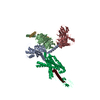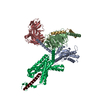+ データを開く
データを開く
- 基本情報
基本情報
| 登録情報 | データベース: PDB / ID: 7ts0 | |||||||||||||||||||||||||||
|---|---|---|---|---|---|---|---|---|---|---|---|---|---|---|---|---|---|---|---|---|---|---|---|---|---|---|---|---|
| タイトル | Cryo-EM structure of corticotropin releasing factor receptor 2 bound to Urocortin 1 and coupled with heterotrimeric Go protein | |||||||||||||||||||||||||||
 要素 要素 |
| |||||||||||||||||||||||||||
 キーワード キーワード | SIGNALING PROTEIN / GPCR / corticotropin releasing factor receptor 2 / Urocortin 1 / Go protein | |||||||||||||||||||||||||||
| 機能・相同性 |  機能・相同性情報 機能・相同性情報histone deacetylase inhibitor activity / corticotropin-releasing hormone receptor activity / corticotrophin-releasing factor receptor activity / corticotropin-releasing hormone receptor 2 binding / positive regulation of corticotropin secretion / positive regulation of behavioral fear response / varicosity / negative regulation of hormone secretion / drinking behavior / response to auditory stimulus ...histone deacetylase inhibitor activity / corticotropin-releasing hormone receptor activity / corticotrophin-releasing factor receptor activity / corticotropin-releasing hormone receptor 2 binding / positive regulation of corticotropin secretion / positive regulation of behavioral fear response / varicosity / negative regulation of hormone secretion / drinking behavior / response to auditory stimulus / negative regulation of appetite / positive regulation of vascular permeability / neuropeptide hormone activity / corticotropin-releasing hormone receptor 1 binding / G-protein activation / Activation of the phototransduction cascade / Glucagon-type ligand receptors / Thromboxane signalling through TP receptor / Sensory perception of sweet, bitter, and umami (glutamate) taste / G beta:gamma signalling through PI3Kgamma / G beta:gamma signalling through CDC42 / Cooperation of PDCL (PhLP1) and TRiC/CCT in G-protein beta folding / negative regulation of cell size / Activation of G protein gated Potassium channels / Inhibition of voltage gated Ca2+ channels via Gbeta/gamma subunits / Ca2+ pathway / G alpha (z) signalling events / High laminar flow shear stress activates signaling by PIEZO1 and PECAM1:CDH5:KDR in endothelial cells / Glucagon-like Peptide-1 (GLP1) regulates insulin secretion / Class B/2 (Secretin family receptors) / Vasopressin regulates renal water homeostasis via Aquaporins / G protein-coupled peptide receptor activity / Adrenaline,noradrenaline inhibits insulin secretion / ADP signalling through P2Y purinoceptor 12 / G alpha (q) signalling events / G alpha (i) signalling events / Thrombin signalling through proteinase activated receptors (PARs) / photoreceptor outer segment membrane / response to pain / negative regulation of feeding behavior / spectrin binding / positive regulation of calcium ion import / startle response / alkylglycerophosphoethanolamine phosphodiesterase activity / positive regulation of cAMP/PKA signal transduction / peptide hormone binding / positive regulation of collagen biosynthetic process / associative learning / social behavior / Synthesis, secretion, and deacylation of Ghrelin / photoreceptor outer segment / neuropeptide signaling pathway / regulation of synaptic transmission, glutamatergic / negative regulation of blood pressure / cardiac muscle cell apoptotic process / axon terminus / photoreceptor inner segment / positive regulation of cardiac muscle contraction / response to glucocorticoid / aerobic respiration / positive regulation of translation / positive regulation of DNA replication / sensory perception of sound / female pregnancy / positive regulation of interleukin-6 production / adenylate cyclase-modulating G protein-coupled receptor signaling pathway / vasodilation / long-term synaptic potentiation / neuron projection development / response to estradiol / heterotrimeric G-protein complex / sensory perception of taste / signaling receptor complex adaptor activity / retina development in camera-type eye / positive regulation of cytosolic calcium ion concentration / cell body / GTPase binding / positive regulation of cell growth / response to oxidative stress / perikaryon / G alpha (s) signalling events / phospholipase C-activating G protein-coupled receptor signaling pathway / cellular response to hypoxia / negative regulation of neuron apoptotic process / cell surface receptor signaling pathway / cell population proliferation / G protein-coupled receptor signaling pathway / negative regulation of gene expression / GTPase activity / synapse / dendrite / protein-containing complex binding / positive regulation of transcription by RNA polymerase II / extracellular region / plasma membrane / cytoplasm 類似検索 - 分子機能 | |||||||||||||||||||||||||||
| 生物種 |  Homo sapiens (ヒト) Homo sapiens (ヒト) synthetic construct (人工物) | |||||||||||||||||||||||||||
| 手法 | 電子顕微鏡法 / 単粒子再構成法 / クライオ電子顕微鏡法 / 解像度: 2.8 Å | |||||||||||||||||||||||||||
 データ登録者 データ登録者 | Zhao, L.-H. / Lin, J. / Mao, C. / Zhou, X.E. / Ji, S. / Shen, D. / Xiao, P. / Melcher, K. / Zhang, Y. / Yu, X. / Xu, H.E. | |||||||||||||||||||||||||||
| 資金援助 |  中国, 中国,  米国, 5件 米国, 5件
| |||||||||||||||||||||||||||
 引用 引用 |  ジャーナル: Nat Commun / 年: 2022 ジャーナル: Nat Commun / 年: 2022タイトル: Structure insights into selective coupling of G protein subtypes by a class B G protein-coupled receptor. 著者: Li-Hua Zhao / Jingyu Lin / Su-Yu Ji / X Edward Zhou / Chunyou Mao / Dan-Dan Shen / Xinheng He / Peng Xiao / Jinpeng Sun / Karsten Melcher / Yan Zhang / Xiao Yu / H Eric Xu /   要旨: The ability to couple with multiple G protein subtypes, such as G, G, or G, by a given G protein-coupled receptor (GPCR) is critical for many physiological processes. Over the past few years, the ...The ability to couple with multiple G protein subtypes, such as G, G, or G, by a given G protein-coupled receptor (GPCR) is critical for many physiological processes. Over the past few years, the cryo-EM structures for all 15 members of the medically important class B GPCRs, all in complex with G protein, have been determined. However, no structure of class B GPCRs with G has been solved to date, limiting our understanding of the precise mechanisms of G protein coupling selectivity. Here we report the structures of corticotropin releasing factor receptor 2 (CRF2R) bound to Urocortin 1 (UCN1), coupled with different classes of heterotrimeric G proteins, G and G. We compare these structures with the structure of CRF2R in complex with G to uncover the structural differences that determine the selective coupling of G protein subtypes by CRF2R. These results provide important insights into the structural basis for the ability of CRF2R to couple with multiple G protein subtypes. | |||||||||||||||||||||||||||
| 履歴 |
|
- 構造の表示
構造の表示
| 構造ビューア | 分子:  Molmil Molmil Jmol/JSmol Jmol/JSmol |
|---|
- ダウンロードとリンク
ダウンロードとリンク
- ダウンロード
ダウンロード
| PDBx/mmCIF形式 |  7ts0.cif.gz 7ts0.cif.gz | 255.9 KB | 表示 |  PDBx/mmCIF形式 PDBx/mmCIF形式 |
|---|---|---|---|---|
| PDB形式 |  pdb7ts0.ent.gz pdb7ts0.ent.gz | 195 KB | 表示 |  PDB形式 PDB形式 |
| PDBx/mmJSON形式 |  7ts0.json.gz 7ts0.json.gz | ツリー表示 |  PDBx/mmJSON形式 PDBx/mmJSON形式 | |
| その他 |  その他のダウンロード その他のダウンロード |
-検証レポート
| 文書・要旨 |  7ts0_validation.pdf.gz 7ts0_validation.pdf.gz | 885.5 KB | 表示 |  wwPDB検証レポート wwPDB検証レポート |
|---|---|---|---|---|
| 文書・詳細版 |  7ts0_full_validation.pdf.gz 7ts0_full_validation.pdf.gz | 890.4 KB | 表示 | |
| XML形式データ |  7ts0_validation.xml.gz 7ts0_validation.xml.gz | 34.2 KB | 表示 | |
| CIF形式データ |  7ts0_validation.cif.gz 7ts0_validation.cif.gz | 53.8 KB | 表示 | |
| アーカイブディレクトリ |  https://data.pdbj.org/pub/pdb/validation_reports/ts/7ts0 https://data.pdbj.org/pub/pdb/validation_reports/ts/7ts0 ftp://data.pdbj.org/pub/pdb/validation_reports/ts/7ts0 ftp://data.pdbj.org/pub/pdb/validation_reports/ts/7ts0 | HTTPS FTP |
-関連構造データ
| 関連構造データ |  26104MC  7tryC M: このデータのモデリングに利用したマップデータ C: 同じ文献を引用 ( |
|---|---|
| 類似構造データ | 類似検索 - 機能・相同性  F&H 検索 F&H 検索 |
- リンク
リンク
- 集合体
集合体
| 登録構造単位 | 
|
|---|---|
| 1 |
|
- 要素
要素
-タンパク質 , 4種, 4分子 PABG
| #1: タンパク質 | 分子量: 63716.246 Da / 分子数: 1 / 由来タイプ: 組換発現 / 由来: (組換発現)  Homo sapiens (ヒト) / 遺伝子: CRHR2, CRF2R, CRH2R Homo sapiens (ヒト) / 遺伝子: CRHR2, CRF2R, CRH2R発現宿主:  参照: UniProt: Q13324 |
|---|---|
| #3: タンパク質 | 分子量: 40032.488 Da / 分子数: 1 / 由来タイプ: 組換発現 / 由来: (組換発現)  Homo sapiens (ヒト) Homo sapiens (ヒト)発現宿主:  |
| #4: タンパク質 | 分子量: 43706.750 Da / 分子数: 1 / 由来タイプ: 組換発現 / 由来: (組換発現)  発現宿主:  参照: UniProt: P54311 |
| #5: タンパク質 | 分子量: 7861.143 Da / 分子数: 1 / 由来タイプ: 組換発現 / 由来: (組換発現)  発現宿主:  |
-タンパク質・ペプチド / 抗体 , 2種, 2分子 UH
| #2: タンパク質・ペプチド | 分子量: 4703.277 Da / 分子数: 1 / Fragment: UNP residues 83-122 / 由来タイプ: 合成 / 由来: (合成)  Homo sapiens (ヒト) / 参照: UniProt: P55089 Homo sapiens (ヒト) / 参照: UniProt: P55089 |
|---|---|
| #6: 抗体 | 分子量: 26277.299 Da / 分子数: 1 / 由来タイプ: 組換発現 / 由来: (組換発現) synthetic construct (人工物) / 発現宿主:  |
-詳細
| 研究の焦点であるリガンドがあるか | N |
|---|---|
| Has protein modification | Y |
-実験情報
-実験
| 実験 | 手法: 電子顕微鏡法 |
|---|---|
| EM実験 | 試料の集合状態: PARTICLE / 3次元再構成法: 単粒子再構成法 |
- 試料調製
試料調製
| 構成要素 | 名称: Corticotropin releasing factor receptor 2 (CRF2R) bound to Urocortin 1 (UCN1) and coupled with G11 proteins タイプ: COMPLEX / Entity ID: all / 由来: MULTIPLE SOURCES |
|---|---|
| 由来(天然) | 生物種:  Homo sapiens (ヒト) Homo sapiens (ヒト) |
| 由来(組換発現) | 生物種:  |
| 緩衝液 | pH: 7.5 |
| 試料 | 包埋: NO / シャドウイング: NO / 染色: NO / 凍結: YES |
| 急速凍結 | 凍結剤: ETHANE |
- 電子顕微鏡撮影
電子顕微鏡撮影
| 実験機器 |  モデル: Titan Krios / 画像提供: FEI Company |
|---|---|
| 顕微鏡 | モデル: FEI TITAN KRIOS |
| 電子銃 | 電子線源:  FIELD EMISSION GUN / 加速電圧: 300 kV / 照射モード: FLOOD BEAM FIELD EMISSION GUN / 加速電圧: 300 kV / 照射モード: FLOOD BEAM |
| 電子レンズ | モード: BRIGHT FIELD / 最大 デフォーカス(公称値): 4000 nm / 最小 デフォーカス(公称値): 1000 nm |
| 撮影 | 電子線照射量: 64 e/Å2 フィルム・検出器のモデル: GATAN K2 SUMMIT (4k x 4k) |
- 解析
解析
| ソフトウェア | 名称: PHENIX / バージョン: 1.13_2998: / 分類: 精密化 | ||||||||||||||||||||||||
|---|---|---|---|---|---|---|---|---|---|---|---|---|---|---|---|---|---|---|---|---|---|---|---|---|---|
| EMソフトウェア | 名称: PHENIX / カテゴリ: モデル精密化 | ||||||||||||||||||||||||
| CTF補正 | タイプ: PHASE FLIPPING AND AMPLITUDE CORRECTION | ||||||||||||||||||||||||
| 3次元再構成 | 解像度: 2.8 Å / 解像度の算出法: FSC 0.143 CUT-OFF / 粒子像の数: 171435 / 対称性のタイプ: POINT | ||||||||||||||||||||||||
| 拘束条件 |
|
 ムービー
ムービー コントローラー
コントローラー




 PDBj
PDBj
















